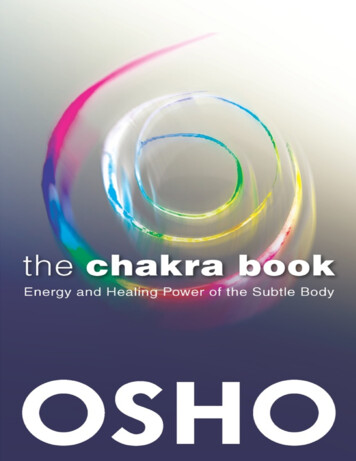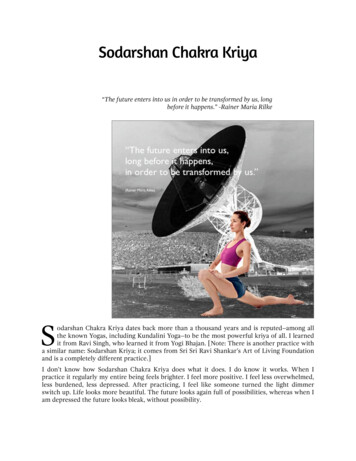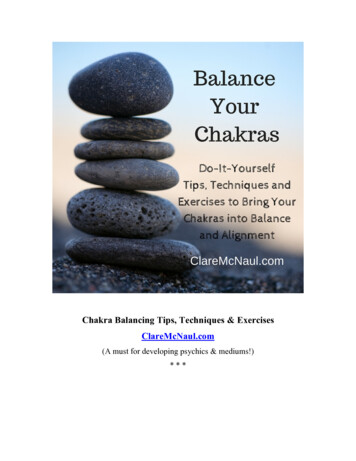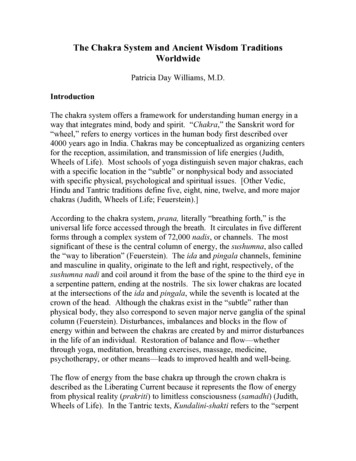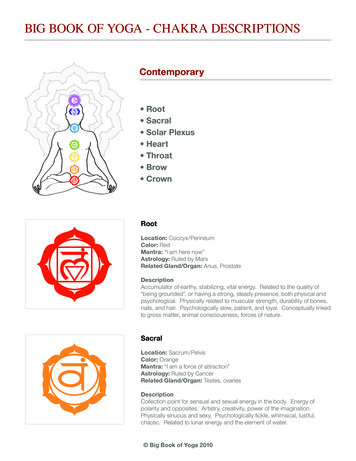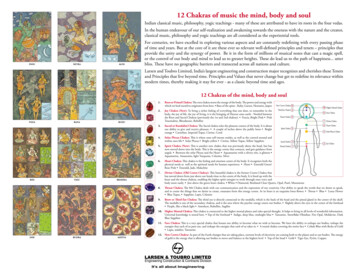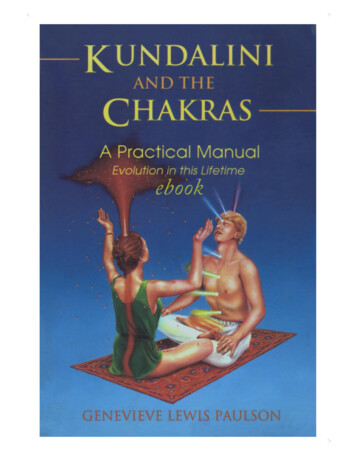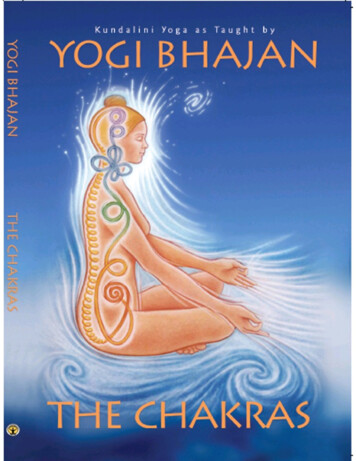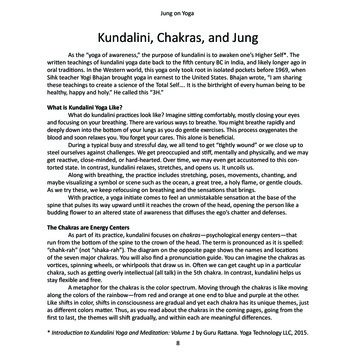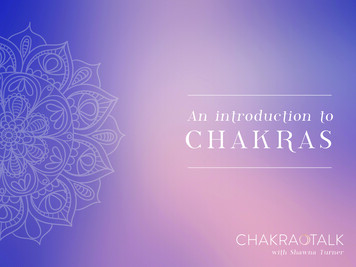
Transcription
An introduction toCHAKRASwith Shawna Turner
What are the Chakras?Chakras are part of the subtle energy system in the body. They govern all elementsof our health and well-being; physical, mental, emotional and spiritual. Chakra isthe Sanskrit word for “wheel”, and chakras are often referred to as spinning wheelsor wheels of light.There are seven major chakras and 21 minor chakras. In this book we’ll explorethe seven main chakras which are positioned along the length of your spine, fromyour root — the space just below your tailbone — to your crown, the top of yourskull.When speaking of the chakras it helps to understand the nadis, which are energychannels in the body. There are said to be 72,000 nadis, but the three primaryones are sushumna, ida, and pingala.Sushumna nadi runs along the spine and is your central energy channel. Sushumnais the channel for awakening Kundalini, or consciousness.Ida and pingala begin in muladhara, the root chakra, and criss-cross their way upthe spine to the crown. Each place they meet is a chakra point.Ida is represented by the moon and governs elements of the divine feminine.Pingala is represented by the sun and governs elements of the divine masculine.In this way, each chakra point has the potential to be balanced and whole.2
Exploring the chakras offers a path for greater healing. As we travel along thechakra system we start to discover more about ourselves and our place in the world.Moving from our root to our crown, we shed old skin and open space for our trueunique talents and gifts.The seven main chakras are interdependent, and if one is out of whack it will affectthe others. Conditions that can throw a chakra off balance include elements fromchildhood, societal pressures, injuries, illness, habits, and relationships.The practice is in learning to find balance in the chakras,and our bodies and everyday life. By studying the chakrasthrough reading and movement, we develop a deeperunderstanding of ourselves.Working through the chakras is not for the faint of heart. But if you’re open tochange and open to channeling in some major energy and light, then this is thework for you.3
ROOT CHAKRAM u l a d h a raLocation: Base of SpineSense: SmellElement: EarthColour: RedBody Parts: Feet, legs, skeletal system, kidneys4
The root chakra deals with security and survival and governs issues like shelter, food, body and body image, familyand finances. The root chakra links us to our community and clan. We carry within us the deep-rooted survivalinstincts of our ancestors — just as genes are passed down through the ancestral lines, so are elements of survival. It’sfrom our ancestors that we gather our grit and gumption.A balanced root chakra is one that will allow us to stand strong in the face ofchange, rooted in ourselves, but adaptable to whatever comes our way.Like a tree we are grounded and secure but flexible enough to sway with the breeze. As majestic as we are on top —we are below.It’s essential to build a strong foundation in order to facilitate healthy growth of your branches. In this way, youmust take care of yourself by eating nutritious food, exercising, and connecting with nature. Keeping your financialhouse in order, spending time with your family and community, and maintaining an orderly living space encouragegrounding and balance within your spiritual home — your body.The root chakra affirms your right to be here. When we believe that we have a right to be here, in this world, just aswe are, we take care of ourselves. And in taking care of ourselves, we are better able to show up for and take care ofour family and friends.Like branches on a tree, we may grow indifferent directions, yet our roots remain as one. Author unknown5
Numerous behaviours can negatively impact the root chakra. These include insecurities about who you are, notbelieving in your basic rights and abilities, and not taking care of your body and your home. If you grew up with orare in a situation where your survival needs are being threatened, a state of fear develops in the root chakra, keepingyour adrenals in overdrive — showing up as the “fight or flight” response. Living with anger and blame, playing therole of victim in our own lives, or running away from life’s challenges all throw this chakra out of balance.We have the ability to face challenges with the courage and strength that have been passed down to us through thegenerations. We nurture our root chakra by taking care of ourselves and by being our own good mother.Remember — you have a right to be here. Just as you are. In this moment. Youare already enough.Tips to balance the root chakra Wear red Spend time in nature Maintain a good home Spend time with family and community Eat nutritious foods Exercise! Yoga, running, dancing.6
S ACRA L CHA K RAS va d h i st h a n aLocation: T wo inches below the navel and into thepelvisSense: TasteElement: WaterColour: OrangeBody Parts: H ips, sacrum, low back, genitals,bladder, sex organs7
Svadhisthana translates as “my own sweet abode.” The sacral chakra is where we form ideas around self-worth anddeservedness. Balance is key for this chakra to function. Balancing work and play, effort and ease, dreaming andmanifestation, desire and gratitude.It’s important to take time to indulge in the simple pleasures of life. What is it that you desire? Once we have ourbasic needs met (root chakra) we’re able to explore what it is that brings us joy.It is said that the sacral chakra is the birthplace of creativity, which shows up as our ability to see the life that we want— and that we know we deserve — and to implement the steps necessary to achieve that life.A balanced sacral chakra will indulge in pleasure and will encourage gratitude forthe life we already have.Movement is a big function in keeping this chakra in check. Repressed emotions are stored throughout the body askarmic imprints and can lead to immobility or feelings of being stuck. Knowing your emotions, and being able toidentify what it is you are feeling are good indicators of a balanced second chakra. Moving our bodies and expressingour emotions can help free these imprints. Giving each and every feeling validity, not labelling some emotions asgood or bad, and sharing emotions in an open and honest way all support a balanced sacral chakra.Cultivation of joy and gratitude is the way home. Brené Brown8
Guilt inhibits balance in this chakra. Knowing what brings you joy is not enough; it’s essential to be present andsensuous in the moment. Taking pleasure while indulging is key. If you are engaging in the act that brings you joy —for example, eating a piece of cake — but are feeling guilty while eating the piece of cake, the pleasure principle willnot be met. And so, there is a good chance that you will eat another piece of cake, feel guilty about that — and onyou go. This is the baseline of addictions.Allow yourself to name what it is you desire and to take full pleasure in fulfillingthose desires.Tips to balance the sacral chakra Wear orange Get in water — flowing water if you can, but if not, take a bath Keep a gratitude journal — at the end of each day write down three things you’re grateful for Make love — to everything — be sensuous in your activities Eat slowly and enjoy every bite Move! Swim, dance, practice yoga.9
SO LAR PLEX US CHAKRAM a n i p u raLocation: Just below the diaphragmSense: SightElement: FireColour: YellowBody Parts: Stomach, muscles, digestive system10
Manipura translates as “city of jewels”. The jewels are power, authenticity, instinct, and courage. The solar plexuschakra is our power center, where we get our grit and gumption and get-up-and-go. Action. This is the center of ourtrue Self.The first two chakras cover our needs and desires, and now we’re here at the center of our being — who we are.They say that the true self is more radiant than the sun, and it’s in the solar plexus that we allow ourselves to be seen.This means we reveal all of ourselves, without shrinking in size or wearing masks. We are seen and heard and wetake up space, just as we are.The third chakra is full of intuition. It rules the gut instinct. You know that feeling in the pit of your stomach whenyou just know that something is right or wrong? That’s your solar plexus guiding your way.It’s in this chakra that we get the courage to do all the great things we’re meant to do.We are full of unlimited potential and a balanced solar plexus allows us to callupon our warrior energy and step into our lives.At the center of your being you have the answer. Youknow who you are and you know what you want. Lao Tzu11
We have a right to act and to attain everything we want. Shame and fear stands in the way of this chakra being fullybalanced and of us reaching our fullest potential. Shame of being who we are, and of acknowledging our needs anddesires. And fear — fear of not being enough, of failing, or being more successful than we’re ready to be.The solar plexus is where we make our decisions. When we are in tune with that gut instinct we are better able tomake decisions that serve our true self. This chakra is charged by self-esteem and confidence. Knowing who we areand establishing ourselves within a community are important in developing a healthy sense of ego. We are then ableto make powerful decisions that are good for ourselves, and good for the community, and that come from a place oftruth and love rather than greed and manipulation.Tips to balance the solar plexus chakra Wear yellow Engage in sensible risk-taking Eat lemons Meditate — find comfort within your Self (meditating with your gaze on the flame of a candle)12
H E A RT C H A KR AA n a h at aLocation: Center of the chestElement: AirSense: TouchColour: GreenBody Parts: H eart, chest and shoulders, lungs,hands13
The heart chakra is all about love. Love — by nature — is unconditional, unlimited and free. It surrounds us and isours to give and receive.Anahata translates as ‘unstruck.’ It refers to the cosmic vibration of the universe, a constant energetic hum that hasno beginning, no middle and no end. It is within this fourth chakra — within our own heart center — that we connectwith the heartbeat of the universe.The divine dwells within, and it is in the heart center that we connect with our own divine nature and begin tounderstand the concept of ‘one.’ We learn that in loving ourselves, we are better able to love others and that wehave a right to love and be loved. A healthy egoism (balanced solar plexus chakra) helps us to love purely and freely,without expectation or imitation, a love based on feeling and inclusion.A balanced heart center shows up as the lover archetype, someone who has thecapacity to love everyone, to give love freely, but also to be open to receiving the loveof others.Without first developing a healthy ego, the heart chakra will be unbalanced. An unbalanced heart chakra can showup as difficulty in loving ourselves and our beliefs around whether we are worthy of the love of others. Whenunbalanced in the heart, we may be withholding of our love, afraid of letting ourselves be seen, or afraid of beinghurt by another.Your heart has not to open to others. Your heart hasto open to yourself. Yogi Bhajan14
The love that we give is based on conditions, attaching how much we give on how much we get, or loving as a rewardfor good action and withholding love as a reaction to negative behaviour. Withholding our love not only affects ourown heart center, but also the development of the heart chakras of those around us.The heart chakra is open when we are born and it is through our relationship with our parents or guardians that weget our first taste of unconditional love. Over time, through the process of growing up, this chakra starts to close.We have our hearts broken, we’re let down in love — possibly by a friend, a parent or partner. We learn to protectour heart space. A little later in life, by meeting our needs and desires, and knowing who we are, we allow our heartcenter to open again. To ourselves first. By taking care of ourselves, and indulging in the things that bring us pleasurewe begin to court our own heart center, showing ourselves what it feels like to be loved without condition. This lovetoward ourselves sets us up to be able to love others unconditionally and to be open to receiving the same.Remember — love is what keeps us all connected, and it begins within the self.Tips to balance the heart chakra Wear green Breathing exercises Spend time with children Eat green fruits and veggies15
T HRO AT C H A K RAVi sh u dd h aLocation: Inner and outer throatElement: EthersSense: SoundColour: Turquoise blueBody Parts: Neck, throat, jaw, ears16
Just as the heart chakra is all about love, the throat chakra is all about Truth. Hearing your truth, speaking yourtruth, living your truth, and connecting to the truth of others.Vishuddha translates as ‘pure’ or ‘purification.’ It relates to living a clean and healthy life, so that we can betterconnect to our fifth chakra. They say that lies, gossip, negative self-talk and any sort of substance abuse that entersthrough the throat are ways of blocking this chakra. To live a pure life means to be clean in body, mind, and spirit.Communication is our connection to the throat chakra — not just what we say,but how we say it — not just what we say, but what we choose to keep inside.Secrets and lies keep us blocked and disconnected from our higher self. It’s important to express ourselves, freelyand openly. Full expression requires one to be vulnerable, and vulnerability is a scary place. Having worked our wayup through the chakras, knowing what we need, what we want, who we are and how to love, we’re able to speak ourtruth with more confidence.How we express ourselves is not just in verbal communication. All the world can see of us, is what we choose toreveal. We reveal ourselves
Chakras are part of the subtle energy system in the body. They govern all elements of our health and well-being; physical, mental, emotional and spiritual. Chakra is the Sanskrit word for “wheel”, and chakras are often referred to as spinning wheels or wheels of light. There are seven major chakras and 21 minor chakras. In this book we’ll explore the seven main chakras which are .
